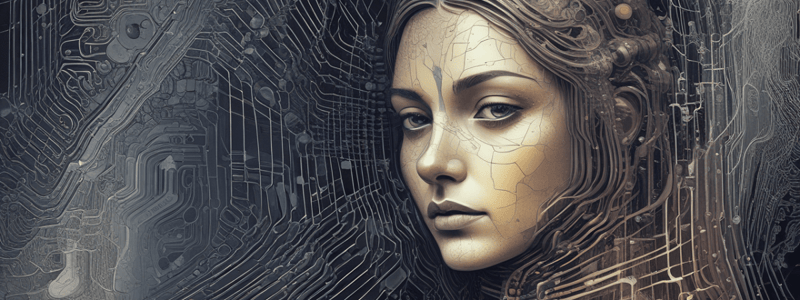Podcast
Questions and Answers
What is the main purpose of the discriminator in a Generative Adversarial Network?
What is the main purpose of the discriminator in a Generative Adversarial Network?
- To generate realistic synthetic images
- To improve super-resolution
- To classify images as Real or Fake (correct)
- To perform image-to-image translation
What is an application of Generative Adversarial Networks?
What is an application of Generative Adversarial Networks?
- Reinforcement learning
- Word embeddings
- Style transfer (correct)
- Transformer models
What is the goal of training a generator and discriminator in a Generative Adversarial Network?
What is the goal of training a generator and discriminator in a Generative Adversarial Network?
- To use the generator for reinforcement learning
- To alternate between training the generator and discriminator (correct)
- To minimize the loss of the generator
- To maximize the loss of the discriminator
What is a type of Generative Adversarial Network application demonstrated in the Nixon DeepFake Clips?
What is a type of Generative Adversarial Network application demonstrated in the Nixon DeepFake Clips?
What is a benefit of using Generative Adversarial Networks for image-to-image translation?
What is a benefit of using Generative Adversarial Networks for image-to-image translation?
What is NOT an application of Generative Adversarial Networks?
What is NOT an application of Generative Adversarial Networks?
What is the main difference between a generator and a discriminator in a Generative Adversarial Network?
What is the main difference between a generator and a discriminator in a Generative Adversarial Network?
What is a resource that provides information on Generative Adversarial Networks?
What is a resource that provides information on Generative Adversarial Networks?
What is the purpose of the Tensorboard callback in training a neural network?
What is the purpose of the Tensorboard callback in training a neural network?
What is the main difference between PointNet and PointNet++?
What is the main difference between PointNet and PointNet++?
What is the input to a Neural Radiance Field (NeRF) network?
What is the input to a Neural Radiance Field (NeRF) network?
What is the purpose of the custom data generator in training a neural network?
What is the purpose of the custom data generator in training a neural network?
What is the main difference between training a Unet and training a YOLOv8?
What is the main difference between training a Unet and training a YOLOv8?
What is the purpose of the Early Stopping callback in training a neural network?
What is the purpose of the Early Stopping callback in training a neural network?
What is the main difference between Point Cloud and 2D Image?
What is the main difference between Point Cloud and 2D Image?
What is the purpose of the checkpoint callback in training a neural network?
What is the purpose of the checkpoint callback in training a neural network?
What is the main difference between Neural Radiance Fields (NeRFs) and Instant-NGP?
What is the main difference between Neural Radiance Fields (NeRFs) and Instant-NGP?
What is the purpose of the custom data augmentation in training a neural network?
What is the purpose of the custom data augmentation in training a neural network?
What is the main concept of Generative Adversarial Networks (GANs)?
What is the main concept of Generative Adversarial Networks (GANs)?
What is the purpose of CycleGAN in image-to-image translation?
What is the purpose of CycleGAN in image-to-image translation?
What is the main idea behind Word Embeddings?
What is the main idea behind Word Embeddings?
What is the key component of the Transformer architecture?
What is the key component of the Transformer architecture?
What is the main goal of Super-Resolution?
What is the main goal of Super-Resolution?
What is the name of the paper that introduced StyleGAN?
What is the name of the paper that introduced StyleGAN?
What is the purpose of the diffusion model in Stable Diffusion?
What is the purpose of the diffusion model in Stable Diffusion?
What is the main concept of ESRGAN?
What is the main concept of ESRGAN?
What is the main goal of Pix2Pix?
What is the main goal of Pix2Pix?
What is the name of the paper that introduced CycleGAN?
What is the name of the paper that introduced CycleGAN?
Flashcards
Inference
Inference
Performing a task using a trained model.
Training
Training
Process of teaching a model to learn from data.
PointNet
PointNet
A deep neural network for 3D classification and segmentation.
PointNet++
PointNet++
Signup and view all the flashcards
Neural Radiance Fields (NeRFs)
Neural Radiance Fields (NeRFs)
Signup and view all the flashcards
Instant-NGP
Instant-NGP
Signup and view all the flashcards
Audio Classification (Sequence Approach)
Audio Classification (Sequence Approach)
Signup and view all the flashcards
Audio Classification (Image Approach)
Audio Classification (Image Approach)
Signup and view all the flashcards
Autoencoders
Autoencoders
Signup and view all the flashcards
Generative Adversarial Networks (GANs)
Generative Adversarial Networks (GANs)
Signup and view all the flashcards
DeepFakes
DeepFakes
Signup and view all the flashcards
Word Embeddings
Word Embeddings
Signup and view all the flashcards
Word2Vec
Word2Vec
Signup and view all the flashcards
Self-Attention Layer
Self-Attention Layer
Signup and view all the flashcards
Text Encoder
Text Encoder
Signup and view all the flashcards
Diffusion Model
Diffusion Model
Signup and view all the flashcards
DALL-E
DALL-E
Signup and view all the flashcards
SORA
SORA
Signup and view all the flashcards
Zero123
Zero123
Signup and view all the flashcards
DreamFusion
DreamFusion
Signup and view all the flashcards
Magic3D
Magic3D
Signup and view all the flashcards
AudioCraft
AudioCraft
Signup and view all the flashcards
MusicGen
MusicGen
Signup and view all the flashcards
AudioGen
AudioGen
Signup and view all the flashcards
EnCodec
EnCodec
Signup and view all the flashcards
Multi Band Diffusion
Multi Band Diffusion
Signup and view all the flashcards
MAGNeT
MAGNeT
Signup and view all the flashcards
Study Notes
Inference and Training
- Inference can be performed with YOLOv8 and DeepLabv3+
- DeepLabv3+ has a demo available on Google Colab
- Training can be done with YOLOv8 and Unet on ISBI (Image Segmentation Benchmark on ISBI dataset)
Homework
- Train Unet on GTA5 dataset using TensorFlow
- Choose specific parameters for training: number of epochs, batch size, loss function, optimizer, and learning rate
- Use custom data generator and custom data augmentation (random translation, random flip)
- Evaluate the model using scikit-learn functions: confusion matrix, precision, recall, F-score, and accuracy
Agenda
- Artificial Intelligence and Computer Vision Application Domains
- Artificial Intelligence and Computer Vision tasks
- Machine Learning and Deep Learning
- Neural Networks
- Neural Networks for Classification in Computer Vision
- Evaluation and Metrics
- Training Neural Networks
- Implementation challenges
- Neural Networks for other Computer Vision tasks
- More Neural Networks
3D Deep Learning
- PointNet: a deep neural network for 3D classification and segmentation
- PointNet++: a hierarchical feature learning method for 3D point sets
- Neural Radiance Fields (NeRFs): a fully-connected network for 3D scene reconstruction
- Instant-NGP: a library for 3D neural rendering
Audio
- Possible approaches to audio classification: take spectrograms of slices of input and treat them as a sequence or take spectrogram of the input and treat it as an image
- Use a Deep Neural Network to process the input
- Hershey et al. (2015) introduced human-level control through deep reinforcement learning
Autoencoders
- Autoencoders are used for dimensionality reduction, anomaly detection, and generative modeling
GANs
- Generative Adversarial Networks (GANs) consist of a generator and discriminator
- Applications: DeepFakes, style transfer, image-to-image translation, and super resolution
- Nixon DeepFake Clips: In Event of Moon Disaster
DL4NLP
- Probabilistic modeling of word occurrences
- Word embeddings – distributed representation
- Word2Vec is a popular embedding
Transformers
- Probabilistic modeling of word occurrences
- Self-Attention Layer: computes attention over the other positions in the sequence
- Multiple heads (K = 8)
Stable Difusion
- Denoising approach
- Text-to-image task
- A text encoder turns prompt into a latent vector
- A diffusion model repeatedly "denoises" a 64x64 latent image patch
Visual Content Generation
- DALL-E: text-to-image
- SORA: text-to-video
- Zero123: image-to-3D
- DreamFusion: text-to-3D using 2D Diffusion
- Magic3D: Text-to-3D
Deepfakes
- Deepfake: video generated by AI, voice by human imitator
- Morgan Freeman
Sound Generation
- AudioCraft: a library for generative audio models
- MusicGen: text-to-music
- AudioGen: text-to-sound
- EnCodec: neural audio codec
- Multi Band Diffusion: decoder using diffusion
- MAGNeT: text-to-music and text-to-sound
Music Generation
- UDIO.com: generates 30-second segments with lyrics
- Suno.com: generates ~2-minute songs with lyrics
Studying That Suits You
Use AI to generate personalized quizzes and flashcards to suit your learning preferences.




